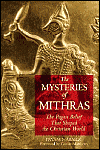
Mithra, an early Indo-Iranian god, was worshipped in Persia (Iran) as early as the second millennium BCE as the “Lord of vast green pastures” and “First Celestial God.” He was a major god in polytheistic Persia before Zoroaster reformed the old religion in the sixth or fifth century BCE and created Zoroastrianism, which is monotheistic. Mithra is also seen in Chinese mythology, where he known as “the Friend,” and it’s possible that he may be the Buddhist Maitreya, the “Benevolent One” or “Friendly One.” Another Mithra was a human being called the Savior who lived in the third century BCE. We are probably most familiar with Mithra in his Roman incarnation, as Mithras. The Roman religion (or cult) arose about 100 BCE and lasted until it was crushed by Christians at the beginning of the fifth century CE.
As a Roman mystery religion or cult, Mithraism had seven degrees of initiation. There may also have been a women’s grade, Hyena. Nabarz refers to Roman, early medieval, and modern scholarly sources that allude to “a fiery female potency.” Because the sex organs of the female hyena are exceedingly similar to the male’s, it was long believed that the hyena could change sexes at will. “If there was such a grade as Hyena for women initiates,” Nabarz writes, “then it was an especially interesting choice, pointing to a potential cross-fertilization of ideas between the Goddess-centered Isis cult and the God-centered Mithras cult…” (pp. 43-44). Curiously, Mithra is a popular girl’s name in Iran today.
This is a delicious book in which we learn of a Mithraic connection to the Tarot, another connection to the Celtic gods and the druids, the significance of the three colors of the national flags of Indo-European countries, and the significance of the old Persian fairy tale of the Simorgh (a fabulous bird who helps the third son of a king fulfill a quest). There is even a correspondence to the Charge of the Goddess in Mithraic ritual.
If you want to read two books at the same time, pick up Reading Lolita in Tehran by Azar Nafisi (Random House, 2004). Nafisi, a professor of English literature, lived through the Iranian revolution of the 1980s, was banned from the universities of Tehran, and formed a secret private class of young women with whom she read forbidden Western novels. Her story shows the egregious influence of religion in today’s Islamic Republic. You may come to the conclusion that today’s American pagans who whine about fundies breaking up their public rituals have little to complain about. You may also regret the disappearance of Mithra from his homeland.
~review by Barbara Ardinger, Ph.D.
Author: Payam Nabarz, Ph.D.
Inner Traditions, 2005
